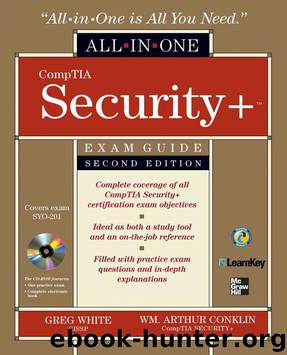CompTIA Security+ All-In-One Exam Guide, Second Edition by Chuck Cothren; Gregory White; Wm. Arthur Conklin; Dwayne Williams; Roger Davis

Author:Chuck Cothren; Gregory White; Wm. Arthur Conklin; Dwayne Williams; Roger Davis
Language: eng
Format: mobi
Tags: Reference.Computer Related Learning
ISBN: 0071601279
Publisher: McGraw-Hill Osborne Media
Published: 2009-01-02T00:00:00+00:00
In the first line, you see a session being opened by a user named bob. This usually indicates that whoever owns the account bob has logged into the system. On the next three lines, you see authentication failures as bob tries to become root—the superuser account that can do anything on the system. In this case, user bob tries three times to become root and fails on each try. This pattern of activity could mean a number of different things—bob could be an admin who has forgotten the password for the root account, bob could be an admin and someone changed the root password without telling him, bob could be a user attempting to guess the root password, or an attacker could have compromised user bob’s account and is now trying to compromise the root account on the system. In any case, our HIDS will work through its decision tree to determine whether an authentication failure in the message log is something it needs to examine. In this instance, when the IDS examines these lines in the log, it will note the fact that three of the lines in the log match one of the patterns it has been told to look for (as determined by information from the decision tree and the signature database), and it will react accordingly, usually by generating an alarm or alert of some type that appears on the user interface or in an e-mail, page, or other form of message.
On a Windows system, the HIDS will likely examine the application logs generated by the operating system. The three logs (application, system, and security) are similar to the logs on a UNIX system, though the Windows logs are not stored as text files and typically require a utility or application to read them. This example uses the security log from a Windows 2000 Professional system:
Download
This site does not store any files on its server. We only index and link to content provided by other sites. Please contact the content providers to delete copyright contents if any and email us, we'll remove relevant links or contents immediately.
Exploring Deepfakes by Bryan Lyon and Matt Tora(8251)
Robo-Advisor with Python by Aki Ranin(8216)
Offensive Shellcode from Scratch by Rishalin Pillay(6374)
Microsoft 365 and SharePoint Online Cookbook by Gaurav Mahajan Sudeep Ghatak Nate Chamberlain Scott Brewster(5598)
Ego Is the Enemy by Ryan Holiday(5292)
Management Strategies for the Cloud Revolution: How Cloud Computing Is Transforming Business and Why You Can't Afford to Be Left Behind by Charles Babcock(4521)
Python for ArcGIS Pro by Silas Toms Bill Parker(4446)
Elevating React Web Development with Gatsby by Samuel Larsen-Disney(4166)
Machine Learning at Scale with H2O by Gregory Keys | David Whiting(4166)
Liar's Poker by Michael Lewis(3367)
Learning C# by Developing Games with Unity 2021 by Harrison Ferrone(3333)
Speed Up Your Python with Rust by Maxwell Flitton(3275)
OPNsense Beginner to Professional by Julio Cesar Bueno de Camargo(3249)
Extreme DAX by Michiel Rozema & Henk Vlootman(3234)
Agile Security Operations by Hinne Hettema(3160)
Linux Command Line and Shell Scripting Techniques by Vedran Dakic and Jasmin Redzepagic(3147)
Essential Cryptography for JavaScript Developers by Alessandro Segala(3117)
Cryptography Algorithms by Massimo Bertaccini(3054)
AI-Powered Commerce by Andy Pandharikar & Frederik Bussler(3021)
